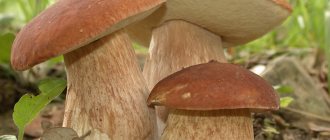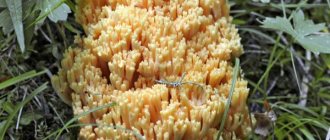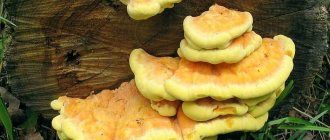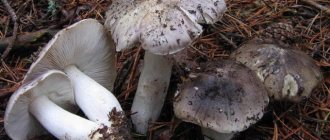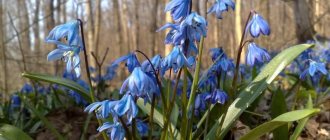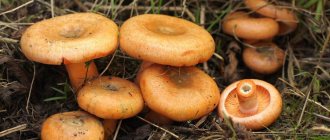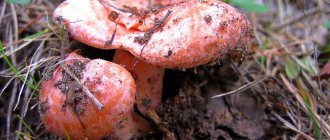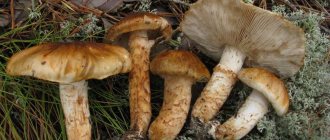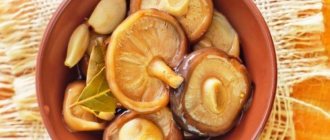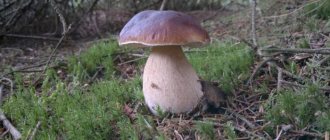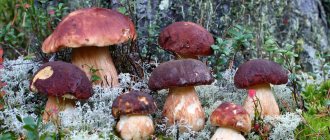The first spring or earliest mushrooms, which are collected by connoisseurs of quiet hunting, appear on European territory as early as March. Edible, as well as inedible and poisonous mushrooms form their fruiting bodies in the spring almost immediately after the snow melts in the forest.
Many species grow in thawed areas and forest edges. To be fair, it should be noted that the types of mushrooms that can be collected in early spring are very few in number, and that is why you need to know which spring mushrooms can be used for food purposes, and which varieties can cause severe poisoning.
What are the first spring mushrooms that are edible?
Edible mushrooms begin to appear a little later. In the southern regions of the country they can be found at the very end of April, in the central and northern regions - at the beginning or middle of May. When going to pick spring mushrooms, you should always remember to be careful. At this time, there is a huge amount of poisonous and so-called “false” mushrooms, which can easily be confused with edible ones. So, what are the names of the first spring mushrooms that can be eaten? Of course, these are morels.
Oyster mushrooms
mushrooms
Oyster mushrooms are capable of producing fruiting bodies throughout the warm season, and in greenhouse conditions - all year round. Therefore, they are readily cultivated on specially created substrates.
Wild oyster mushrooms grow on stumps and dead trees and feed on wood. They grow in groups, have thin, stiff legs and large, round, shell-shaped caps, gray or whitish in color.
The size of the cap reaches 17 cm, its edges are folded downwards. These are safe mushrooms that can be prepared in many ways without risking your health. Suitable for frying, soups and other dishes. Oyster mushrooms are sold in most large stores all year round; almost all people have seen them at least once in their lives, and therefore it is almost impossible to confuse them with other fruiting bodies when collecting.
More about morels
These are edible spring mushrooms. For example, in the Moscow region they are already beginning to be considered a rarity. You can’t meet them in every forest. There is an opinion that they are gradually disappearing. In our country and in Europe, morels have been known as edible since the middle of the 16th century. Their detailed description can be seen in European books on botany and in Russian herbalists.
They appear singly or in groups in forests, parks, and can be found in gardens and orchards. They grow next to deciduous trees: poplar, aspen, alder, etc. These spring mushrooms are found during the flowering of fruit crops. There are different types of morels:
- common morel;
- round;
- conical;
- morel cap, etc.
Here is a description of the most common morels.
Conical morel
The height of the cap is up to 6 cm, thickness up to 5 cm. Externally, it is conical, sometimes ovoid, its edges grow together with the stem. The inside of the cap is hollow; there are elongated cells on the surface. Its color is dark brown or gray-yellow-brown. The length of the leg is up to 5 cm, its thickness is up to 2 cm. Cylindrical, hollow, painted white or slightly yellowish. Its pulp is thin, brittle, waxy.
Roseoplate thyroid
mushroom
also has another name - podabrikosovik, because it grows in the southern regions of Russia, and likes to settle in places inhabited by humans, under fruit trees - pears, apricots, and so on.
Interesting: The deepest rivers in the world: list, depth, where they are located, photos and videos
The mushroom is brown in color, its size is usually small - within 10 cm. While the mushroom is young, its cap has a conical shape with a blunt end, but then it opens, but its edges remain curved. The leg can reach 12 cm in height. These mushrooms are rarely eaten boiled or fried, but are usually canned to create a delicious, flavorful snack.
Are morels poisonous?
These spring mushrooms, photos of which can be seen in this article, do not contain toxic substances. These are quite valuable gifts from the forest, in great demand in the West. For example, in the USA they are considered one of the best. In the States, morels stand out from other mushrooms because of their cost, which often exceeds $150 per 1 kg. So there is no need to be afraid of them - these spring mushrooms are edible.
Considering that morels can be confused with strings (we’ll talk about them below), it’s worth heat treating them before eating them. Boil them for 15-20 minutes, then change the water and repeat the process. Then they need to be washed with cold water, and then fried or boiled without fear for your health. All poisonous toxins pass from the mushroom into water when boiled.
Stitches
In Russia you can find two types of them: ordinary and giant. Lines in forests can be seen much more often; they are more tenacious and undemanding to external conditions. Like morels, they grow under deciduous trees and also like to be found near rotting trunks, branches and stumps. The stitches are distinguished by their voluminous, irregularly shaped caps, which have deep convolutions. Their legs are also sinuous and powerful, painted grayish-white. The cap can be ocher, light brown or yellowish brown.
Meadow honey mushrooms
Meadow honey mushrooms
Meadow honey mushrooms, or clove honey mushrooms, are unpretentious; they also begin to appear in the spring. These mushrooms are not at all afraid of drought; if, after drying out, water gets on them, they come to life again and take on their previous appearance.
The cap grows up to 9 cm; in damp conditions they have a mucous surface, which disappears in dry weather. The color may be yellow or reddish-brown, becoming lighter in the sun. These mushrooms can be used for preservation, they can also be fried and boiled - they are completely harmless and extremely tasty.
Interesting: The largest predators in Russia - list, description, size, photo and video
Are the lines edible?
Russian experts consider these mushrooms to be conditionally edible. In other words, they are suitable for food, but only after boiling. As for experts from the West, they believe that the lines are classified as poisonous. This is due to recorded cases of severe poisoning by these mushrooms, some of which were fatal. All these cases occurred because people ate the strings raw, just like morels.
In fact, these mushrooms do contain poisonous toxins that are destroyed when cooked. Our mushroom pickers recommend repeatedly processing the lines. Repeated boiling of these mushrooms leads to the destruction of toxins, which minimizes the risk of poisoning. Of course, we do not recommend collecting these mushrooms for inexperienced people who do not know how to process them correctly.
Collibia, photo 2021
In the month of May, the first mushrooms are replaced by new ones, no less tasty and healthy. And although they do not stand out in size, they look very appetizing, and the pleasant aroma attracts you to them.
You can prepare collibia any way you like by performing heat treatment. It consists of several stages: cleaning, washing and boiling, draining the water.
Safety precautions
Firstly, if a person decides to try the lines, then he should follow all the rules mentioned above. Secondly, if there is even a shred of doubt that everything was done correctly, then it is better to abandon them. In addition, if it is difficult for an inexperienced mushroom picker to distinguish a string from a morel, then you should not collect them yourself. It is not recommended to purchase mushrooms at the market or from strangers. Among them there may be poisonous specimens, and it is not known where they were collected. If the mushrooms grew next to the road or in places with an unfavorable environment, then even morels can be harmful to health.
Petsitsa orange
This is another first spring mushroom. These are bright, small, orange mushrooms. Young specimens look like bowls; later they become flat, resembling plates and saucers. People call them saucers. These mushrooms are related to morels and strings. They grow right on the ground, along forest paths and on the edges. They often appear in places where there used to be fires.
Scaly tinder
This mushroom is popularly called variegated tinder fungus, variegated tinder fungus, elm fungus, and hare fungus. You can find it on tree trunks; it is usually located low.
The fungus prefers deciduous trees and can settle on both living and dead trunks. This species is found in the middle zone and the Far East.
The scaly tinder fungus is distinguished by an asymmetrical fleshy cap, which can reach a diameter of 30 cm. At first, the cap is kidney-shaped, then it becomes prostrate and can be slightly depressed at the base.
The spongy cork pulp crumbles, it is soft only at the beginning, then it becomes harder. There is a mealy but pleasant aroma. Many people note that the aroma of the mushroom is reminiscent of fresh cucumbers.
The cap of the scaly tinder fungus is light yellowish or grayish in color. The entire surface is covered with wavy dark brown scales.
The mushroom stalk can reach a length of 10 cm and a thickness of 4 cm. The upper part of the stalk is reticulate and whitish, becoming brownish-black towards the base.
Only the young scaly polypore is edible. You can determine whether a mushroom is edible by pinching off a piece of the cap - it should crumble.
In terms of taste and nutritional properties, the caps of scaly polypores are of greater value. They can be fried, made into soup or cutlets. It is first recommended to grind the pulp and boil it.
Is it possible to eat them?
Orange arctic mushrooms are edible spring mushrooms, unlike their brown counterparts. They are practically odorless, and there is no taste at all. They are often used for pickling together with assorted mushrooms, as they add brightness to it. They can be fried or boiled; however, they lose their color, but they retain it when pickled. These spring mushrooms, photos of which can be seen in this article, are often used to decorate various salads and dishes. Dried mushrooms are powdered and added to seasonings and sauces to give them their orange color.
And finally, let us remind you once again that for safety reasons, morels and strings should be boiled twice before eating. And arctic foxes are edible only in a bright orange color. All shades of brown and gray colors indicate the toxicity of the mushroom. Be careful and only go into the forest accompanied by experienced mushroom pickers.
Early Polevik or Early Vole Agrocybe praecox
Early field grass or Early field vole Agrocybe praecox
Mushroom of the Bolbitiaceae family, loving rich, well-fertilized soil. It grows in groups from early June to mid-July on the slopes of ravines, clearings and edges, and the sides of forest paths. It can settle on heavily rotted wood. Many mushroom pickers call it “unfinished champignon” due to its external similarity, but it has a very good taste and is suitable for any culinary processing and use, except for drying.
Appearance
The cap is from 3 to 8 cm in diameter. It has a yellowish tint, which darkens over time. In young specimens it has the shape of a hemisphere, but as the mushroom ages, it straightens out more and more until it straightens out completely. The plates are wide, often located, light yellowish in color. As the mushroom ages, it gradually darkens, eventually becoming a dirty brown color. In young mushrooms they are covered with a protective membrane, which breaks over time, hanging in pieces on the edges of the cap and leaving a characteristic ring on the stem.
The leg is up to 8 cm high and up to 1 cm in diameter. The inside is hollow, but hard, dense and fibrous. Its color is slightly darker than the cap, especially in the lower part, and becomes darker with age.
In addition to the mushrooms described above, spring gives us many other early forest guests:
